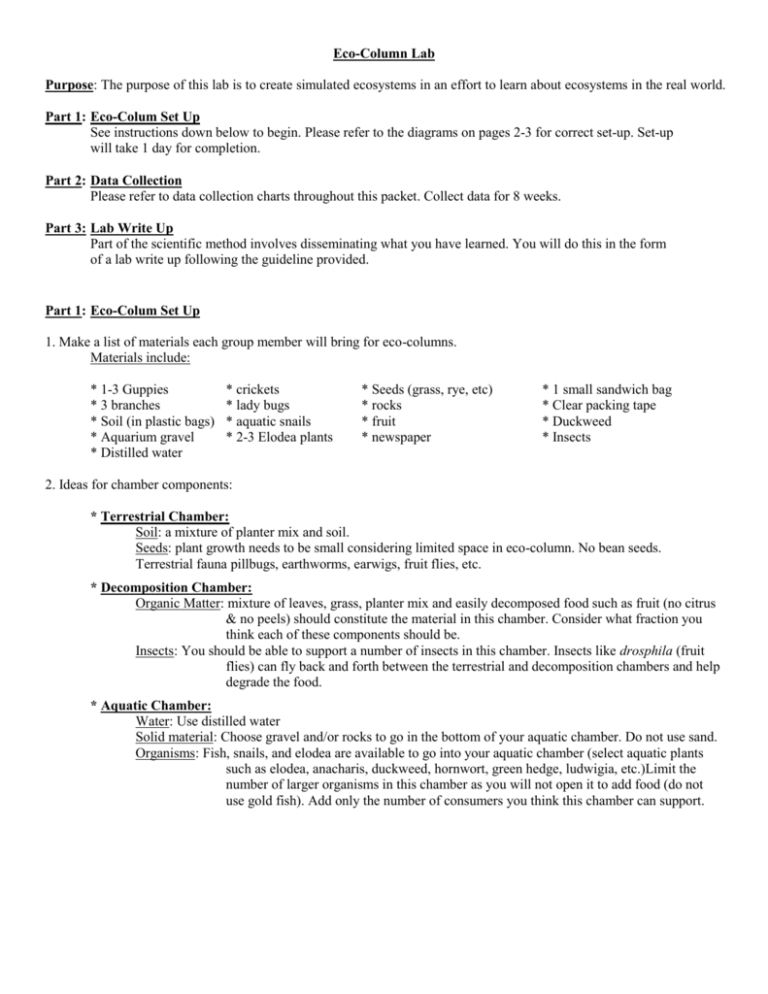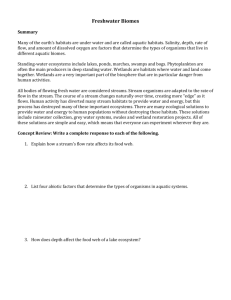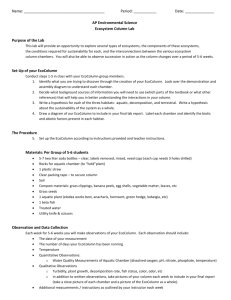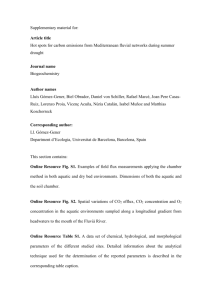Eco Column Lab
advertisement

Eco-Column Lab Purpose: The purpose of this lab is to create simulated ecosystems in an effort to learn about ecosystems in the real world. Part 1: Eco-Colum Set Up See instructions down below to begin. Please refer to the diagrams on pages 2-3 for correct set-up. Set-up will take 1 day for completion. Part 2: Data Collection Please refer to data collection charts throughout this packet. Collect data for 8 weeks. Part 3: Lab Write Up Part of the scientific method involves disseminating what you have learned. You will do this in the form of a lab write up following the guideline provided. Part 1: Eco-Colum Set Up 1. Make a list of materials each group member will bring for eco-columns. Materials include: * 1-3 Guppies * 3 branches * Soil (in plastic bags) * Aquarium gravel * Distilled water * crickets * lady bugs * aquatic snails * 2-3 Elodea plants * Seeds (grass, rye, etc) * rocks * fruit * newspaper * 1 small sandwich bag * Clear packing tape * Duckweed * Insects 2. Ideas for chamber components: * Terrestrial Chamber: Soil: a mixture of planter mix and soil. Seeds: plant growth needs to be small considering limited space in eco-column. No bean seeds. Terrestrial fauna pillbugs, earthworms, earwigs, fruit flies, etc. * Decomposition Chamber: Organic Matter: mixture of leaves, grass, planter mix and easily decomposed food such as fruit (no citrus & no peels) should constitute the material in this chamber. Consider what fraction you think each of these components should be. Insects: You should be able to support a number of insects in this chamber. Insects like drosphila (fruit flies) can fly back and forth between the terrestrial and decomposition chambers and help degrade the food. * Aquatic Chamber: Water: Use distilled water Solid material: Choose gravel and/or rocks to go in the bottom of your aquatic chamber. Do not use sand. Organisms: Fish, snails, and elodea are available to go into your aquatic chamber (select aquatic plants such as elodea, anacharis, duckweed, hornwort, green hedge, ludwigia, etc.)Limit the number of larger organisms in this chamber as you will not open it to add food (do not use gold fish). Add only the number of consumers you think this chamber can support. Part 2: Data Collection Water Quality Standards Dissolved Oxygen (DO) : 5 ppm to 15 ppm is healthy for fish Trout need 10 ppm, Carp 2 ppm, Bass 5.5 ppm Guppies, 6 ppm, Tiger barbs, 7 ppm Temperature (C ) : Guppies and Tiger barbs, 20 to 25 degrees Celsius is best pH : 6.7 to 8.6 is best for fish Turbidity: aquatic systems, 0 to 10 NTU (Nephelometric Turbidity Units) Drinking water, 0 to 3 NTU Nitrates: aquatic systems, 0 to 1 ppm Drinking water, 0 to 10 ppm Phosphates: aquatic systems, 0 to 1 ppm Salinity: freshwater aquatic systems, 0 to 500 ppm Drinking water, 0 to 250 ppm TDS (total dissolved solids, MgCO3, CaCO3, etc.) Freshwater aquatic systems, 100 to 200 ppm Drinking water, 0 to 500 ppm Ecocolumn Data Collection Scales Aquatic Fauna Live Turbidity Scale Odor Scale (for Aquatic Habitat) Dead Crystal Clear = 1 Slightly Cloudy = 2 Moderately Cloudy = 3 Very Cloudy = 4 Blackish or Brownish = 5 No Odor = 1 Slight Odor = 2 Smelly = 3 Very Smelly = 4 Devastating = 5 Part 3: Lab Write Up In this eco-column write-up, your job is to clearly present the information about your eco-column. Your report should include each of the sections below (plus a good title). The heart of your report should be your analysis and conclusion. Do not just answer the questions but use this write-up as an opportunity to demonstrate your knowledge and ideas. This is a formal lab report and should follow these guidelines: I. Background Information What is an eco-column and why is it a useful tool? How is it like or unlike an ecosystem outside? Is it an open or closed system? Provide an introduction. II. Hypothesis: This should be a statement indicating what you thing the results of your investigation will be. III. Materials Please list the materials & equipment that you used during the lab. Whenever possible indicate the number of items used or the amount used. This list should be complete enough so anyone else could use this list & duplicate the lab. IV. Procedure This is an explanation of your experimental setup & the steps that you followed in conducting your observations or experiment. Along with written text, illustrations may be used here if they help to provide a clearer understanding for the reader. If your investigation involves an experiment, this is where you should identify your control, and both the independent & dependent variables. V. Results (data) This is the part of your lab report where your raw data will be displayed. This is customarily done using a chart or table. Make sure your charts and tables are appropriately labeled. Use a computer when making your tables and make sure they are roomy enough for the data. There should also be room in this section of the report where you record observations & comments about what happened during your investigation. VI. Analysis This is the most important part of your report and will represent the largest part of your lab report grade. If you are doing a team report, the analysis should be the result of a team discussion about the data and observations that you collected. Paragraph form should be used to explain what the data means. Did you observe any strong correlations, or cause and effect results? Why did things unfold and proceed the way they did? Did your results turn out the same as others? If your data can be graphed, please support your text with graphs that help to explain your analysis. Choose 1 of the nutrient cycles (C, N or P) and diagram and explain how you think it would occur in your eco-column. VII. Conclusion What conclusions can you make about your eco-column. Decide whether or not your data and observations supported your hypothesis. Then tell us what you learned through your research. What connections can you make between your eco-column and a natural ecosystem or community? VIII. Sources of Error Please identify sources of error & weaknesses in your investigation. These could include equipment malfunctions, calculation or data collection errors, or simple human mistakes such as performing a test incorrectly. Sources of error could also include poor experimental design. Checklist of possible items expected to be found in the Analysis section of the Eco-column report. 1. Description of the carbon cycle found in one or more of the habitats. 2. Description of the water cycle found in one or more of the habitats. 3. Description of the nitrogen cycle found in one or more of the habitats. 4. Description of the phosphorous cycle found in one or more of the habitats. 5. A description of food chains in 1 or more of the habitats. 6. A description of food webs in 1 or more of the habitats. 7. Identification of producers, consumers, decomposers, detritus feeders, & scavengers in 1 or more of the habitats. 8. Analysis of the effect of changing DO levels on the viability of the biota. 9. Analysis of the effect of pH on the biota. 10. Analysis of the effect of temperature on the biota. 11. Analysis of the effect of nitrogen levels on the biota. 12. Analysis of the effect of phosphorous levels on the biota. 13. Analysis of why there was odor changes in the habitats. 14. Analysis of why there was turbidity changes in the aquatic habitat. 15. Discussion and description of the various organisms and their effects in the decomposition chamber. 16. Discussion of the limiting factors affecting various organisms in the three habitats. 17. Description of the Range of Tolerance for various organisms in the three habitats. 18. Identification and discussion of examples of Competitive Exclusion in the three habitats. 19. Discussion on the possible causes of Eutrophication in the aquatic chamber. 20. Discussion on the interrelationship among the three habitats. 21. Identification of organism found in all 3 habitats. 22. Description and discussion concerning microorganisms found in the aquatic habitat. 23. Discussion concerning the life and death of the fish. 24. Discussion on how the availability of light affected the habitats in the eco-column. 25. Discussion on the synergistic affect of multiple variables. 26. Discussion analyzing the role of complexity in an ecosystem. 27. Analysis concerning the differences among the various eco-columns: Why did some aquatic habitats remain crystal clear why others turned black or brown and murky? 28. Discussion of factors that affected the growth of the flora in the terrestrial chamber. 29. Discussion of factors that affected the rate of decomposition in the decomposition chamber. 30. Identification and discussion of any examples of predation, parasitism, mutualism, or commensalisms. 31. Discussion of how energy flows through the ecosystems. 32. Observations of intraspecific or interspecific competition or territoriality. 33. Observations of interference competition or exploitation competition. 34. Descriptions of resource partitioning. 35. Discussion of why some eco-columns showed greater inertia or persistence than others. 36. Discussion of why some eco-columns showed greater resilience than others. Checklist of possible items expected to be found in the Conclusions section of the Eco-column report. 1. Decomposition in the aquatic chamber increases turbidity which reduces incoming light and decreases plant photosynthesis. 2. If the fish and snails die, then their will be less carbon dioxide available for the plants. 3. The carbon cycle was demonstrated by the absorption of carbon dioxide by plants and their eventual decomposition. 4. The hydrologic cycle could be observed and was driven by the heat lamp. 5. The eco-column was a good example of the delicate balance between abiotic and biotic factors. 6. Fungus and bacteria in the decomposition chamber help break down organic matter into inorganic nutrients. 7. Abiotic factors such as soil and air serve as nutrients for biotic factors. 8. Several food chains were observed such as light to plants to protists to fish to decomposers. 9. Net primary productivity is not high enough to maintain a complex, viable ecosystem. 10. The fish die when the DO level falls below 5ppm. 11. Real ecosystems are more complex and thus more resilient than the “artificial” eco-column. 12. A limiting factor for the fish was the amount of DO in the water. 13. High levels of nitrates in the water let to eutrophication. 14. Low pH levels will affect the viability of the eco-column. ECOCOLUMN LAB GRADING RUBRIC LAB REPORT SECTIONAL DESCRIPTIONS POINTS AVAILABLE PURPOSE: Was the overall purpose of the laboratory 1 investigation effectively communicated? BACKGROUND INFORMATION: Was there a wide variety of background information from several different sources? Did 3 the background information lay a solid foundation for further research and investigation? HYPOTHESIS: Were legitimate hypotheses presented for each 4 of the ecocolumn’s three environments? MATERIALS: Was a complete and accurate list of materials 2 used during the lab presented? DATA COLLECTION: Was there a thorough presentation of the data that was collected during the investigation? Were there 8 drawings, charts, and graphs that helped with the understanding and interpretation of the data and the overall investigation? ANALYSIS: Was the team able to identify biogeochemical cycles, food chains, food webs, ecosystem roles, and limiting factors? Was the team able to make cause and effect, and 8 correlational connections between abiotic factors such as dissolved oxygen levels, temperature, and pH, and the living organisms in the ecocolumn? (See Analysis List for detailed Analysis section grading) CONCLUSION: Was the team able to make meaningful overall conclusions based on their analysis? Did their data and analysis 3 support their hypotheses? SOURCES OF ERROR: Did the lab report include a 1 comprehensive discussion of possible errors? SUBTOTAL OF POINTS EARNED 30 POINTS EARNED ECOCOLUMN LAB GRADING RUBRIC LAB REPORT SECTIONAL DESCRIPTIONS POINTS AVAILABLE PURPOSE: Was the overall purpose of the laboratory investigation 1 effectively communicated? BACKGROUND INFORMATION: Was there a wide variety of background information from several different sources? Did the 3 background information lay a solid foundation for further research and investigation? HYPOTHESIS: Were legitimate hypotheses presented for each of 4 the ecocolumn’s three environments? MATERIALS: Was a complete and accurate list of materials used 2 during the lab presented? DATA COLLECTION: Was there a thorough presentation of the data that was collected during the investigation? Were there 8 drawings, charts, and graphs that helped with the understanding and interpretation of the data and the overall investigation? ANALYSIS: Was the team able to identify biogeochemical cycles, food chains, food webs, ecosystem roles, and limiting factors? Was the team able to make cause and effect, and correlational 8 connections between abiotic factors such as dissolved oxygen levels, temperature, and pH, and the living organisms in the ecocolumn? (See Analysis List for detailed Analysis section grading) CONCLUSION: Was the team able to make meaningful overall conclusions based on their analysis? Did their data and analysis 3 support their hypotheses? SOURCES OF ERROR: Did the lab report include a 1 comprehensive discussion of possible errors? SUBTOTAL OF POINTS EARNED 30 ECOCOLUMN LAB GRADING RUBRIC LAB REPORT SECTIONAL DESCRIPTIONS POINTS AVAILABLE PURPOSE: Was the overall purpose of the laboratory investigation 1 effectively communicated? BACKGROUND INFORMATION: Was there a wide variety of background information from several different sources? Did the 3 background information lay a solid foundation for further research and investigation? HYPOTHESIS: Were legitimate hypotheses presented for each of 4 the ecocolumn’s three environments? MATERIALS: Was a complete and accurate list of materials used 2 during the lab presented? DATA COLLECTION: Was there a thorough presentation of the data that was collected during the investigation? Were there 8 drawings, charts, and graphs that helped with the understanding and interpretation of the data and the overall investigation? ANALYSIS: Was the team able to identify biogeochemical cycles, food chains, food webs, ecosystem roles, and limiting factors? Was the team able to make cause and effect, and correlational 8 connections between abiotic factors such as dissolved oxygen levels, temperature, and pH, and the living organisms in the ecocolumn? (See Analysis List for detailed Analysis section grading) CONCLUSION: Was the team able to make meaningful overall conclusions based on their analysis? Did their data and analysis 3 support their hypotheses? SOURCES OF ERROR: Did the lab report include a 1 comprehensive discussion of possible errors? SUBTOTAL OF POINTS EARNED 30 POINTS EARNED POINTS EARNED






